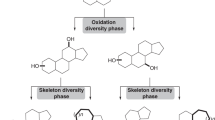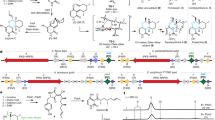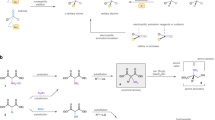Abstract
Biologically active natural products often contain particularly challenging structural features and functionalities in terms of synthesis. Perhaps the greatest difficulties are those caused by issues of stereochemistry. A useful strategy for synthesizing such molecules is to devise methods of bond formation that provide opportunities for using enantioselective catalysis. In using this tactic, the desire for a particular target structure ultimately drives the development of catalytic methods. New enantioselective catalytic methods contribute to a greater fundamental understanding of how bonds can be constructed and lead to valuable synthetic technologies that are useful for a variety of applications.
This is a preview of subscription content, access via your institution
Access options
Subscribe to this journal
Receive 51 print issues and online access
$199.00 per year
only $3.90 per issue
Buy this article
- Purchase on Springer Link
- Instant access to full article PDF
Prices may be subject to local taxes which are calculated during checkout









Similar content being viewed by others
References
Corey, E. J. & Cheng, X.-M. The Logic of Chemical Synthesis (Wiley, 1995).
Jacobsen, E. N., Pfaltz, A. & Yamamoto, H. (eds) Comprehensive Asymmetric Catalysis Vol. I–III (Springer, 2000).
Jacobsen, E. N., Pfaltz, A., Yamamoto, H. (eds) Comprehensive Asymmetric Catalysis Suppl. 1 & 2 (Springer, 2004).
Hoveyda, A. H. in Stimulating Concepts in Chemistry (eds Vögtle, F., Stoddart, J. F. & Shibasaki, M.) 145–160 (Wiley-VCH, 2000).
Trost, B. M. Asymmetric catalysis: an enabling science. Proc. Natl Acad. Sci. USA 101, 5348–5355 (2004).
Taylor, M. S. & Jacobsen, E. N. Asymmetric catalysis in complex target synthesis. Proc. Natl Acad. Sci. USA 101, 5368–5373 (2004).
Diels, O. & Alder, K. Synthesen in der Hydroaromatischen Reihe. Justus Liebigs Ann. Chem. 460, 98–122 (1928).
Stork, G., van Tamalen, E. E., Friedman, L. J. & Burgstahler, A. W. Cantharidin. A stereospecific total synthesis. J. Am. Chem. Soc. 73, 4501 (1951).
Woodward, R. B., Bader, F. E., Bickel, H., Frey, A. J. & Kierstead, R. W. The total synthesis of reserpine. J. Am. Chem. Soc. 78, 2023–2025 (1956).
Yates, P. & Eaton, P. Acceleration of the Diels–Alder reaction by aluminum chloride. J. Am. Chem. Soc. 82, 4436–4437 (1960).
Hashimoto, S.-i., Komeshima, N. & Koga, K. Asymmetric Diels–Alder reaction catalysed by chiral alkoxyaluminium dichloride. J. Chem. Soc. Chem. Commun. 437–438 (1979).
Hayashi, Y. in Cycloaddition Reactions in Organic Synthesis (eds Kobayashi, S. & Jørgensen, K.) 5–55 (Wiley-VCH, 2002).
Corey, E. J. Catalytic enantioselective Diels–Alder reactions: methods, mechanistic fundamentals, pathways, and applications. Angew. Chem. Int. Edn Engl. 41, 1650–1667 (2002).
Nicolaou, K. C., Snyder, S. A., Montagnon, T. & Vassilikogiannakis, G. The Diels–Alder reaction in total synthesis. Angew. Chem. Int. Edn Engl. 41, 1668–1698 (2002).
Corey, E. J. et al. Total synthesis of prostaglandins. Synthesis of the pure dl-E1, -F1α, -F1β, -A1, and -B1 hormones. J. Am. Chem. Soc. 90, 3245–3247 (1968).
Corey, E. J., Bakshi, R. K., Shibata, S., Chen, C.-P. & Singh, V. K. A stable and easily prepared catalyst for the enantioselective reduction of ketones. Applications to multistep syntheses. J. Am. Chem. Soc. 109, 7925–7926 (1987).
Corey, E. J & Helal, C. J. Reduction of carbonyl compounds with chiral oxazaborolidine catalysts: a new paradigm for enantioselective catalysis and a powerful new synthetic method. Angew. Chem. Int. Edn Engl. 37, 1986–2012 (1998).
Yoon, T. P. & Jacobsen, E. N. Privileged chiral catalysts. Science 229, 1691–1693 (2003).
Nájera, C. & Sansano, J. M. Catalytic asymmetric synthesis of α-amino acids. Chem. Rev. 107, 4584–4671 (2007).
Senanayake, C. H. & Jacobsen, E. N. in Process Chemistry in the Pharmaceutical Industry (ed. Gadamasetti, K. G.) 347–368 (Marcel Dekker, 1999).
Akutagawa, S. & Tani, K. in Catalytic Asymmetric Synthesis (ed. Ojima, I.) 145–161 (Wiley-VCH, 2002).
Nugent, W. A., RajanBabu, T. V. & Burk, M. J. Beyond nature's chiral pool: enantioselective catalysis in industry. Science 259, 479–483 (1993).
Farina, V., Reeves, J. T., Senanayake, C. H. & Song, J. J. Asymmetric synthesis of active pharmaceutical ingredients. Chem. Rev. 106, 2734–2793 (2006).
Blaser, H.-U. & Schmidt, E. (eds) Asymmetric Catalysis on Industrial Scale: Challenges, Approaches and Solutions (Wiley-VCH, 2004).
Eder, U., Sauer, G. & Wiechert, R. New type of asymmetric cyclization to optically active steroid CD partial structures. Angew. Chem. Int. Edn Engl. 10, 496–497 (1971).
Hajos, Z. G. & Parrish, D. R. Stereocontrolled total synthesis of 19-nor steroids. J. Org. Chem. 38, 3244–3249 (1973).
Hajos, Z. G. & Parrish, D. R. Asymmetric synthesis of bicyclic intermediates of natural product chemistry. J. Org. Chem. 39, 1615–1621 (1974).
Evans, D. A., Fitch, D. M., Smith, T. E. & Cee, V. J. Application of complex aldol reactions to the total synthesis of phorboxazole B. J. Am. Chem. Soc. 122, 10033–10046 (2000).
Palomo, C., Oiarbide, M. & García, J. M. The aldol addition reaction: an old transformation at constant rebirth. Chem. Eur. J. 8, 37–44 (2002).
Ma, J.-A. Recent developments in the catalytic asymmetric synthesis of α- and β-amino acids. Angew. Chem. Int. Edn Engl. 42, 4290–4299 (2003).
Juaristi, E. & Soloshonok, V. A. (eds) Enantioselective Synthesis of β-Amino Acids (Wiley, 2005).
Vineyard, B. D., Knowles, W. S., Sabacky, M. J., Bachman, G. L. & Weinkauff, D. J. Asymmetric hydrogenation. Rhodium chiral bisphosphine catalyst. J. Am. Chem. Soc. 99, 5946–5952 (1977).
Lubell, W. D., Kitamura, M. & Noyori, R. Enantioselective synthesis of β-amino acids based on BINAP–ruthenium(ii) catalyzed hydrogenation. Tetrahedr. Asymmetry 2, 543–554 (1991).
Drexler, H.-J. et al. Chiral β-amino acid derivatives via asymmetric hydrogenation. Org. Process Res. Dev. 7, 355–361 (2003).
Drucker, D., Easley, C. & Kirkpatrick, P. Sitagliptin. Nature Rev. Drug Discovery 6, 109–110 (2007).
Hsiao, Y. et al. Highly efficient synthesis of β-amino acid derivatives via asymmetric hydrogenation of unprotected enamines. J. Am. Chem. Soc. 126, 9918–9919 (2004). This paper describes the discovery of the rhodium-catalysed enantioselective hydrogenation of β-enamino amide and ester substrates.
Shultz, C. S. & Krska, S. W. Unlocking the potential of asymmetric hydrogenation at Merck. Acc. Chem Res. 40, 1320–1326 (2007).
Xu, F. et al. Mechanistic evidence for an α-oxoketene pathway in the formation of β-ketoamides/esters via Meldrum's acid adducts. J. Am. Chem. Soc. 126, 13002–13009 (2004).
Clausen, A. M. et al. Identification of ammonium chloride as an effective promoter of the asymmetric hydrogenation of β-enamine amide. Org. Process Res. Dev. 10, 723–726 (2006). This paper details efforts to scale up the enantioselective hydrogenation of a β-enamino amide towards the industrial-scale synthesis of the type 2 diabetes treatment sitagliptin (Januvia), as well as the impact of using ammonium chloride as an additive to maintain efficiency and selectivity in this process.
Noyori, R., Kitamura, M. & Ohkuma, T. Toward efficient asymmetric hydrogenation: architectural and functional engineering of chiral molecular catalysts. Proc. Natl Acad. Sci. USA 101, 5356–5362 (2004).
Negishi, E.-i. & de Meijere, A. (eds) Handbook of Organopalladium Chemistry for Organic Synthesis Vol. 1 (Wiley, 2002).
de Meijere, A. & Diederich, F. (eds) Metal-Catalyzed Cross-Coupling Reactions Vols 1 & 2 (Wiley-VCH, 2004).
Luh, T.-Y., Leung, M.-K. & Wong, K.-T. Transition metal-catalyzed activation of aliphatic C–X bonds in carbon–carbon bond formation. Chem. Rev. 100, 3187–3204 (2000).
Frisch, A. C. & Beller, M. Catalysts for cross-coupling reactions with non-activated alkyl halides. Angew. Chem. Int. Edn Engl. 44, 674–688 (2005).
Netherton, M. R. & Fu, G. C. in Topics in Organometallic Chemistry: Palladium in Organic Synthesis (Tsuji, J. ed.) 85–108 (Springer, 2005).
Kiso, Y., Tamao, K., Miyake, N., Yamamoto, K. & Kumada, M. Asymmetric cross-coupling reactions of sec-alkyl Grignard reagents with organic halides in the presence of a chiral phosphine–nickel complex as a catalyst. Tetrahedr. Lett. 15, 3–6 (1974).
Hayashi, T. et al. Asymmetric synthesis catalyzed by chiral ferrocenylphosphine–transition metal complexes. 2. Nickel- and palladium-catalyzed asymmetric Grignard cross-coupling. J. Am. Chem. Soc. 104, 180–186 (1982).
Fischer, C. & Fu, G. C. Asymmetric nickel-catalyzed Negishi cross-couplings of secondary α-bromo amides with organozinc reagents. J. Am. Chem. Soc. 127, 4594–4595 (2005).
Arp, F. O. & Fu, G. C. Catalytic enantioselective Negishi reactions of racemic secondary benzylic halides. J. Am. Chem. Soc. 127, 10482–10483 (2005).
Zhou, J. & Fu, G. C. Cross-couplings of unactivated secondary alkyl halides: room-temperature nickel-catalyzed Negishi reactions of alkyl bromides and iodides. J. Am. Chem. Soc. 125, 14726–14727 (2003).
Son, S. & Fu, G. C. Nickel-catalyzed asymmetric Negishi cross-couplings of secondary allylic chlorides with alkylzincs. J. Am. Chem. Soc. 130, 2756–2757 (2008). This paper describes the use of two sequential nickel-catalysed asymmetric Negishi cross-coupling reactions in the formal synthesis of fluvirucinine A 1.
Suh, Y.-G. et al. Asymmetric total synthesis of fluvirucinine A1 . Angew. Chem. Int. Edn Engl. 38, 3545–3547 (1999).
Douglas, C. J. & Overman, L. E. Catalytic asymmetric synthesis of all-carbon quaternary stereocenters. Proc. Natl Acad. Sci. USA 101, 5363–5367 (2004).
Heck, R. F. Palladium-catalyzed reactions of organic halides with olefins. Acc. Chem. Res. 12, 146–151 (1979).
Overman, L. E. Application of intramolecular Heck reactions for forming congested quaternary carbon centers in complex molecule total synthesis. Pure Appl. Chem. 66, 1423–1430 (1994).
Sato, Y., Sodeoka, M. & Shibasaki, M. Catalytic asymmetric carbon–carbon bond formation: asymmetric synthesis of cis-decalin derivatives by palladium-catalyzed cyclization of prochiral alkenyl iodides. J. Org. Chem. 54, 4738–4739 (1989).
Carpenter, N. E., Kucera, D. J. & Overman, L. E. Palladium-catalyzed polyene cyclizations of trienyl triflates. J. Org. Chem. 54, 5846–5848 (1989).
Dounay, A. B. & Overman, L. E. The asymmetric intramolecular Heck reaction in natural product total synthesis. Chem. Rev. 103, 2945–2963 (2003).
Saxton, J. E. (ed.) Chemistry of Heterocyclic Compounds: Indoles, Part Four, The Monoterpenoid Indole Alkaloids (Wiley, 1983).
Dounay, A. B., Overman, L. E. & Wrobleski, A. D. Sequential catalytic asymmetric Heck–iminium ion cyclization: enantioselective total synthesis of the Strychnos alkaloid minfiensine. J. Am. Chem. Soc. 127, 10186–10187 (2005).
Dounay, A. B., Humphreys, P. G., Overman, L. E. & Wrobleski, A. D. Total synthesis of the Strychnos alkaloid (+)-minfiensine: tandem enantioselective intramolecular Heck–iminium ion cyclization. J. Am. Chem. Soc. 130, 5368–5377 (2008). This paper provides a full account of the use of the palladium-catalysed enantioselective Heck reaction for total synthesis of the alkaloid minfiensine.
Kirmansjah, L. & Fu, G. C. Intramolecular Heck reactions of unactivated alkyl halides. J. Am. Chem. Soc. 129, 11340–11341 (2008).
Sundberg, R. J. Indoles (Academic, 1996).
Humphrey, G. R. & Kuethe, J. T. Practical methodologies for the synthesis of indoles. Chem. Rev. 106, 2875–2911 (2006).
Jensen, K. B., Thorhauge, J., Hazell, R. G. & Jørgensen, K. A. Catalytic asymmetric Friedel–Crafts alkylation of β,γ-unsaturated α-ketoesters: enantioselective addition of aromatic C–H bonds to alkenes. Angew. Chem. Int. Edn Engl. 40, 160–163 (2001).
Paras, N. A. & MacMillan, D. W. C. New strategies in organic catalysis: the first enantioselective organocatalytic Friedel–Crafts alkylation. J. Am. Chem. Soc. 123, 4370–4371 (2001).
Lelais, G. & MacMillan, D. W. C. Modern strategies in organic catalysis: the advent and development of iminium activation. Aldrichimica Acta 39, 79–87 (2006).
Erkkilä, A., Majander, I. & Pihko, P. M. Iminium catalysis. Chem. Rev. 107, 5416–5470 (2007).
Austin, J. F. & MacMillan, D. W. C. Enantioselective organocatalytic indole alkylations. Design of a new and highly effective chiral amine for iminium catalysis. J. Am. Chem. Soc. 124, 1172–1173 (2002).
Hino, T. & Nakagawa, M. in The Alkaloids Vol. 34 (ed. Brossi, A.) 1–75 (Academic, 1988).
Overman, L. E., Paone, D. V. & Stearns, B. A. Direct stereo- and enantiocontrolled synthesis of vicinal stereogenic quaternary carbon centers. Total syntheses of meso- and (−)-chimonanthine and (+)-calycanthine. J. Am. Chem. Soc. 121, 7702–7703 (1999).
Overman, L. E., Larrow, J. F., Stearns, B. A. & Vance, J. M. Enantioselective construction of vicinal stereogenic quaternary stereocenters by dialkylation: practical total syntheses of (+)- and meso-chimonanthine. Angew. Chem. Int. Edn Engl. 39, 213–215 (2000).
Depew, K. M. et al. Total synthesis of 5-N-acetylardeemin and amauromine: Practical routes to potential MDR reversal agents. J. Am. Chem. Soc. 121, 11953–11963 (1999).
Austin, J. F., Kim, S.-G., Sinz, C. J., Xiao, W.-J. & MacMillan, D. W. C. Enantioselective organocatalytic construction of pyrroloindolines by a cascade addition-cyclization strategy: synthesis of (−)-flustramine B. Proc. Natl Acad. Sci. USA 101, 5482–5487 (2004). This paper describes the use of imidazolidinone catalysts for enantioselective Friedel–Crafts reactions with indole nucleophiles for the synthesis of the potassium-channel blocker flustramine B.
Pictet, A. & Spengler, T. Über die Bildung von Isochinolin-derivaten durch Einwirkung von Methylal auf Phenyl-äthylamin, Phenyl-alanin und Tyrosin. Ber. Dtsch. Chem. Ges. 44, 2030–2036 (1911).
Cox, E. D. & Cook, J. M. The Pictet–Spengler condensation: a new direction for an old reaction. Chem. Rev. 95, 1797–1842 (1995).
Allin, S. M., Gaskell, S. N., Elsegood, M. R. J. & Martin, W. P. A new asymmetric synthesis of the natural enantiomer of the indolizidino[8,7-b]indole alkaloid (+)-harmicine. Tetrahedr. Lett. 48, 5669–5671 (2007).
Taylor, M. S. & Jacobsen, E. N. Highly enantioselective catalytic acyl-Pictet–Spengler reactions. J. Am. Chem. Soc. 126, 10558–10559 (2004).
Seayad, J., Seayad, A. M. & List, B. Catalytic asymmetric Pictet–Spengler reaction. J. Am. Chem. Soc. 128, 1086–1087 (2006).
Wanner, M. J., van der Haas, R. N. S., de Cuba, K. R., van Maarseveen, J. H. & Hiemstra, H. Catalytic asymmetric Pictet–Spengler reactions via sulfenyliminium ions. Angew. Chem. Int. Edn Engl. 46, 7485–7487 (2007).
Raheem, I. T., Thiara, P. S., Peterson, E. A. & Jacobsen, E. N. Enantioselective Pictet–Spengler-type cyclizations of hydroxylactams: H-bond donor catalysis by anion binding. J. Am. Chem. Soc. 129, 13404–13405 (2007). This paper describes development of the thiourea-catalysed enantioselective Pictet–Spengler-type cyclization reaction used in the synthesis of the compound harmicine, which is active against leishmaniasis.
Raheem, I. T., Thiara, P. S. & Jacobsen, E. N. Regio- and enantioselective catalytic cyclization of pyrroles onto N-acyliminium ions. Org. Lett. 10, 1577–1580 (2008).
Reisman, S. E., Doyle, A. G. & Jacobsen, E. N. Enantioselective thiourea-catalyzed additions to oxocarbenium ions. J. Am. Chem. Soc. 130, 7198–7199 (2008).
Dolling, U.-H., Davis, P. & Grabowski, E. J. J. Efficient catalytic asymmetric alkylations. 1. Enantioselective synthesis of (+)-indacrinone via chiral phase-transfer catalysis. J. Am. Chem. Soc. 106, 446–447 (1984). This paper describes the use of cinchoninium catalysts for enantioselective enolate alkylation towards synthesizing the diuretic indacrinone.
Hughes, D. L., Dolling, U.-H., Ryan, K. M., Schoenewaldt, E. F. & Grabowski, E. J. J. Efficient catalytic asymmetric alkylations. 3. A kinetic and mechanistic study of the enantioselective phase-transfer methylation of 6,7-dichloro-5-methoxy-2-phenyl-1-indanone. J. Org. Chem. 52, 4745–4752 (1987).
Maruoka, K. (ed.) Asymmetric Phase Transfer Catalysis (Wiley-VCH, 2008).
Enquist, J. A. Jr & Stoltz, B. M. The total synthesis of (−)-cyanthiwigin F by means of double catalytic enantioselective alkylation. Nature 453, 1228–1231 (2008). This paper details the use of palladium-catalysed enantioselective enolate alkylation for the total synthesis of the marine natural product cyanthiwigin F.
Mohr, J. T. & Stoltz, B. M. Enantioselective Tsuji allylations. Chem. Asian J. 2, 1476–1491 (2007).
Behenna, D. C. & Stoltz, B. M. The enantioselective Tsuji allylation. J. Am. Chem. Soc. 126, 15044–15045 (2004).
Mohr, J. T., Behenna, D. C., Harned, A. M. & Stoltz, B. M. Deracemization of quaternary stereocenters by Pd-catalyzed enantioconvergenent decarboxylative allylation of racemic β-ketoesters. Angew. Chem. Int. Edn Engl. 44, 6924–6927 (2005).
Mohr, J. T., Ebner, D. C. & Stoltz, B. M. Catalytic enantioselective stereoablative reactions: an unexploited approach to enantioselective catalysis. Org. Biomol. Chem. 5, 3571–3576 (2007).
Yamago, S. & Nakamura, E. [3 + 2] Cycloaddition of trimethylenemethane and its synthetic equivalents. Org. React. 61, 1–217 (2002).
Trost, B. M. & Chan, D. M. T. New conjunctive reagents. 2-Acetoxymethyl-3-allyltrimethylsilane for methylenecyclopentane annulations catalyzed by palladium(0). J. Am. Chem. Soc. 101, 6429–6432 (1979).
Trost, B. M. & Chan, D. M. T. 2-Acetoxymethyl-3-allyltrimethylsilane and palladium(0): a source of trimethylenemethane–palladium complex? J. Am. Chem. Soc. 101, 6432–6433 (1979).
Trost, B. M., Cramer, N. & Bernsmann, H. Concise total synthesis of (±)-marcfortine B. J. Am. Chem. Soc. 129, 3086–3087 (2007). This paper describes the synthetic route to (±)-marcfortine B.
Le Marquand, P. & Tam, W. Enantioselective palladium-catalyzed trimethylenemethane [3 + 2] cycloadditions. Angew. Chem. Int. Edn Engl. 47, 2926–2928 (2008).
Yamamoto, A., Ito, Y. & Hayashi, T. Asymmetric [3 + 2] cycloaddition of 2-(sulfonylmethyl)-2-propenyl carbonate catalyzed by chiral ferrocenylphosphine–palladium complexes. Tetrahedr. Lett. 30, 375–378 (1989).
Trost, B. M., Stambuli, J. P., Silverman, S. M. & Schwörer, W. Palladium-catalyzed asymmetric [3 + 2] trimethylenemethane cycloaddition reactions. J. Am. Chem. Soc. 128, 13328–13329 (2006).
Trost, B. M., Cramer, N. & Silverman, S. M. Enantioselective construction of spirocyclic oxindolic cyclopentanes by palladium-catalyzed trimethylenemethane [3 + 2]-cycloaddition. J. Am. Chem. Soc. 129, 12396–12397 (2007). This paper describes palladium-catalysed enantioselective TMM [3 +2]-cycloaddition with oxindoles, which might provide an enantioselective route to marcfortine B.
Trost, B. M., Silverman, S. M. & Stambuli, J. P. Palladium-catalyzed asymmetric [3 + 2] cycloaddition of trimethylenemethane with imines. J. Am. Chem. Soc. 129, 12398–12399 (2007).
Acknowledgements
We thank the National Institute of General Medical Sciences (grant number R01GM080269-01), Eli Lilly (which provided predoctoral fellowships to J.T.M. and M.R.K.), Amgen, Abbott Laboratories, Boehringer Ingelheim, Merck, Bristol–Myers Squibb and the California Institute of Technology for financial support.
Author information
Authors and Affiliations
Ethics declarations
Competing interests
The authors declare no competing financial interests.
Additional information
Reprints and permissions information is available at http://www.nature.com/reprints.
Correspondence should be addressed to B.M.S. (stoltz@caltech.edu).
Rights and permissions
About this article
Cite this article
Mohr, J., Krout, M. & Stoltz, B. Natural products as inspiration for the development of asymmetric catalysis. Nature 455, 323–332 (2008). https://doi.org/10.1038/nature07370
Published:
Issue Date:
DOI: https://doi.org/10.1038/nature07370
This article is cited by
-
Atroposelective hydroarylation of biaryl phosphines directed by phosphorus centres
Nature Communications (2023)
-
Chiral recognition of neutral guests by chiral naphthotubes with a bis-thiourea endo-functionalized cavity
Nature Communications (2023)
-
A facile and efficient method for the synthesis of crystalline tetrahydro-β-carbolines via the Pictet-Spengler reaction in water
Scientific Reports (2020)
-
Enantioselective recognition at mesoporous chiral metal surfaces
Nature Communications (2014)
-
Enantioselective protonation
Nature Chemistry (2009)
Comments
By submitting a comment you agree to abide by our Terms and Community Guidelines. If you find something abusive or that does not comply with our terms or guidelines please flag it as inappropriate.



